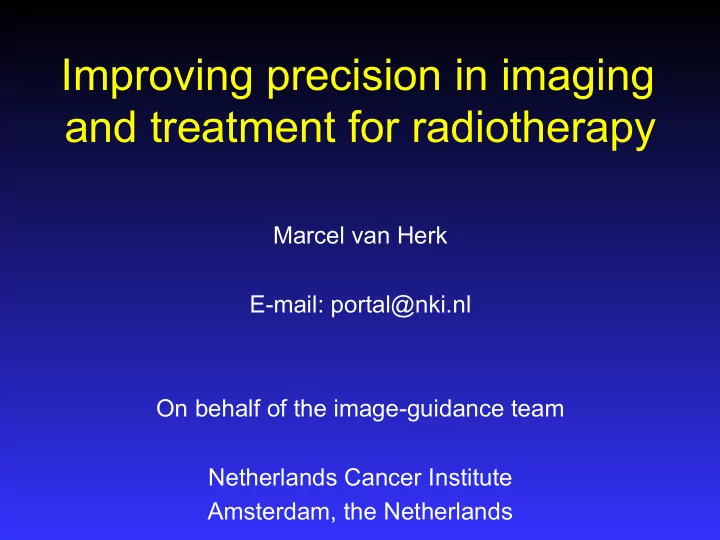

Improving precision in imaging and treatment for radiotherapy Marcel van Herk E-mail: portal@nki.nl On behalf of the image-guidance team Netherlands Cancer Institute Amsterdam, the Netherlands
Classic radiotherapy procedure Align patient on machine on Tattoo, align and scan patient tattoos and treat (many days) Draw target and plan treatment on RTP In principle this procedure should be accurate but …
Things are uncertain! Imaging and delineation Treatment
Improving precision in imaging • Improve image acquisition to collect representative data • MRI: DTI, CE • 4D CT, 4D PET • Image post-processing • Training and consensus • Gather clinical knowledge • Can we close the diagnostic gap ?
Advanced imaging under treatment conditions: 4D PET/CT Free-breathing treatment requires free-breathing imaging - Shows correct tumor shape and its components - Shows range of respiratory motion - Allows optimal tumor targeting taking motion into account
Post-processing to Mid-position CT: clinical at NKI since 6 months 4DCT 4D Deformable DVF registration Deform 4DCT to local mean pos. Average frames Mid-position CT Wolthaus et al, Med Phys 2008
Mid-ventilation versus mid-position reconstruction (deformable registration) for free-breathing CT 7 Mid-ventilation (one bin) Median of all bins deformed pixel by pixel to mid-position
Delineation variation: CT versus CT + PET CT (T 2 N 2 ) CT + PET (T 2 N 1 ) SD 7.5 mm SD 3.5 mm Steenbakkers et al, IJROBP 2005
Effect of training and peer collaboration on target volume definition teacher students groups Material collected during ESTRO teaching course on target volume delineation
But what about the CTV ? • By definition disease between the GTV and the CTV cannot be detected • Instead, the CTV is defined by means of margin expansion of the GTV and/or anatomical boundaries • Very little is known of margins in relation to the CTV • Very little clinical / pathology data • Models to be developed
Hard data: microscopic extensions in lung cancer N=32 100 30% patients with low grade tumors (now 90 treated with SBRT with 80 few mm margins), have % cases with extensions spread at 15 mm distance 70 60 100% 50 Deformation 50% 40 corrected 25% 30 20 10 0 0 5 10 15 20 25 30 35 40 45 distance from GTV [mm] Having dose there may be essential! The impact of microscopic disease on the tumor control probability in non-small-cell lung cancer. Christian Siedschlag et al, R&O 2011
Estimate pattern of spread from response to incidental dose in clinical trial data (high risk prostate patients) Average dose no failures – average dose failures ≈ 7 Gy p = 0.02 - = PSA controls PSA failures 100% 1.0 ≥ median 0.8 80% 60% 0.6 0.4 40% < median (53.1 Gy) 0.2 20% p = 0.000 Treatment group IV, Hospital A (n=67) 0.0 0% 0 12 24 36 48 60 72 0 3 6 Y Witte et al, IJROBP2009; Chen et al, ICCR2010
How to detect microscopic disease ? • Closing the diagnostic gap: the cancer spread too big to respond to drugs but too small to be visible on diagnostic images • Optical techniques such as optical coherence tomography may be the future In vivo esophagus; 10 µ m voxel size
Image guidance thoughts • There is currently a trade-off between IGRT imaging speed and quality of information Fast: 2D for bone / markers Slower: 3D for soft tissue guidance Still slower: 4D for moving structures Slowest: ART: use many days scans to adapt to deformations Optimal choice depends on frequency distribution of organ motion
Are markers perfect ? Base Sem. Vesicles Apex à +/-1 cm margin required Best: combine markers with van der Wielen, IJROBP 2008 low dose CBCT Smitsmans, IJROBP 2010
0.4 cGy 3 cGy Seeds allow low dose imaging 0.35 mm Visicoils Seeds and soft tissue (seminal vesicles) visualized in low dose 1 minute scan Daily image guidance using markers for prostate body ART after one week based on position of the seminal vesicles
3D imaging is problematic when motion occurs during scanning
Alternative: 4D IGRT imaging, but scan time is quite long
Challenge: 3D acquisition blurred and 4D acquisition slow One backprojection Reconstructed 3D CT image
Solution: in-line motion compensated reconstruction (motion estimated prior in 4D planning CT) One backprojection Reconstructed CT image
Non-corrected (3D) CBCT Long scan (4 min) Short scan (1 min)
Motion-compensated CBCT Long scan (4 min) Short scan (1 min) In clinical use at AVL since January, 2012
Differential motion Planning CT 4D-CBCT No couch correction can solve this problem CTV
Adaptive RT using an average patient model DVF <DVF> Open issue: efficient implementation for those patients that need it
Conclusions • Target volume definition is by far the weakest link in radiotherapy • New imaging tools, but in particular consensus and consultation are important ways to improve this situation • To improve CTV definition, analysis of large outcome databases is necessary • Improvements in image guidance are still being made: but the most difficult step - adaptation to complex deformations - remains to be made in clinical practice
Thank you for your attention
Recommend
More recommend